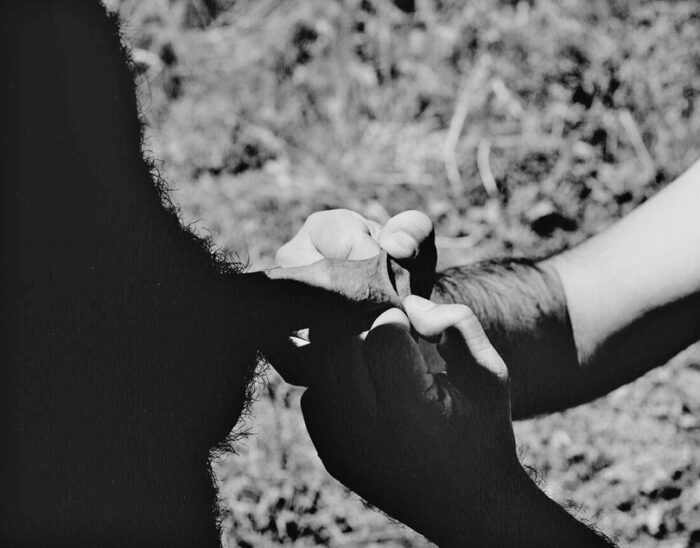
Sun pounds thirsty ground. Two guys—bearish, without inhibitions, brown—fuck across several photographs in “Hunger for the Absolute,” Mark McKnight’s solo show here. Surveying these and the equal number of uninhabited “straight” landscapes (turned pervy through sheer adjacency), a discerning ’mo might have paused to reflect upon a pair of visionary American photographers, certainly McKnight’s forebears: Laura Aguilar (who is no longer alive) and Jack Fritscher (who is still up and kicking). Both contributed to the cultural and communal sensibilities underlying the unrepentantly queer expressions that McKnight, and those similarly attuned, makes prodigious use of today. So let’s pause for a brief invocation and sing our praises to Aguilar for her technical precision and for the discerning placement of her own queer, fat, and brown body in the dramatic desert landscapes of California’s Coachella Valley and offer a hosanna—or three—to the polymathic Fritscher, the gonzo writer, sometime photographer, and former editor of Drummer (the watershed leather publication that did much to deliver BDSM into the hands, hearts, and dungeons of many a fledgling kinkster).
Like Fritscher, McKnight serves us editorial sex. His photographs depict, in high-contrast black-and-white, moments of beatific calm in the midst of carnal frenzy. Voidpull (all works 2021), for example, tightly frames the sweet tugging one man is giving to another man’s foreskin, while Tear foregrounds the same pair locked in an amorous grip: The right hand of one guy presses deeply into his partner’s flesh. Untitled is the only picture that captures anal penetration outright; it is framed by a thick white mat, which highlights the work’s exceptional status. This piece was paired with a view of a dreamy, dark, and cloud-laden sky that inevitably called to mind Alfred Stieglitz’s sublime photographs of clouds (the “Equivalents” series, 1922–34), which the artist believed “put down my philosophy of life—to show that [the success of] my photographs [was] not due to subject matter—not to special trees, or faces, or interiors, to special privileges, clouds were there for everyone—no tax as yet on them—free.” Of course, McKnight eschews such an objective approach: When an upturned hollow of a fallen tree is given the title Untitled (Tree Void), a viewer is meant to make the morphological connection between a log, a dick, and an asshole; the deadwood becomes remarkable through its purposeful concatenation with images of bodies and their orifices.
One of the things most difficult to convey when addressing practices that traffic in overtly sexual imagery is the cheesiness this kind of work can occasionally fall into. The ur-example would be the artfully posed beefcake photographs of the late Bob Mizer (who sometimes shot his models in the Mojave Desert), but a more recent case would be the sun-drenched Polaroids of Tom Bianchi, who since the ’70s has portrayed the palpable joy and sexual energy of normatively attractive gay men on New York’s Fire Island and later in Palm Springs, California (where Bianchi now lives). Take Worship, in which one of McKnight’s models lies prostrate, framed by the crotch of another man standing over him. Industrial metal chains form catenary shadows crisscrossing the prone man’s body. It’s a visual cliché (whips and chains = BDSM), and in the end not much separates this photograph from something that might be found in the recent rebrand/relaunch of Drummer (or the no-longer-in-print Dutch hipster-homo magazine Butt). This is perhaps the point. The broader art world has yet to give more than a glance at erotic work of the kind McKnight produces. But that these photographs function reasonably well as porn and art suggests their placement within a broader lineage of homosexy work, because to understand some of the visual language and queer symbolism McKnight employs requires a concomitant knowledge not only of Aguilar’s and Fritscher’s output, but also of the works of Alvin Baltrop, Lanee Bird, Rick Castro, John Preston, Efren Ramirez, Rink, Jim Stewart, and Lou Thomas’s Target Studios, to name only a few. McKnight belongs to this motley storied history of picturing queer sex.